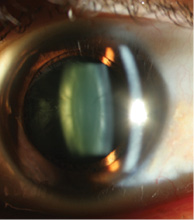Many early presbyopic patients, bothered by their new reading glasses or bifocals, come to us in hopes of reducing their dependence on spectacles. Today, we have several procedures that can make this a reality. Laser vision correction (LVC) procedures at the corneal plane have never been better. Furthermore, presbyopia-correcting corneal inlays are now approved by the FDA. In some ways, cornea-based procedures could be viewed as less invasive than intraocular procedures; however, most of us noticed a trend some time ago: Patients who underwent cornea-based presbyopic LVC were returning years later, stating that their vision correction had worn off. (In actuality, they had progressed through the natural aging changes of the crystalline lens.)
Enter the concept of dysfunctional lens syndrome (DLS): a spectrum of changes characterized by a dysfunctionality of the lens due to loss of accommodation, early opacities, and increased higher-order aberrations (HOAs). Although many patients with DLS (Figure) may still have 20/20 distance UCVA, advanced diagnostic devices objectively quantify the characteristics and visual function of an aging lens, including Scheimpflug imaging (»Pentacam, Oculus Optikgeräte) for lens densitometry, double-pass wavefront technology (HD Analyzer, Visiometrics) to quantify and analyze ocular light scatter and retinal image quality, and ray-tracing devices (»iTrace, Tracey Technologies) to create a dysfunctional lens index. These diagnostics can streamline the clinical decision-making process and improve patient education of DLS.

Figure. DLS is characterized by loss of accommodation, early opacities, and increased HOAs.
Once patients are diagnosed and staged with DLS, we reassure them that this is a normal aging process. Our patients are taken on a digital tour of their eyes, where we demonstrate that we can perform vision correction on the cornea or on the internal lens. In patients with presbyopia only—stage 1 DLS—we typically suggest a cornea-based solution, unless they are moderate to high hyperopes, in which case we suggest a lens-based procedure. In patients with an early opacity and increasing HOAs—stage 2 DLS—we typically recommend a lens-based procedure, unless they are high axial myopes (due to risk of retinal detachment), in which case we may defer to a corneal-based procedure. In patients with advancing opacity and HOAs affecting their daily activities—stage 3 DLS—we recommend a cataract procedure.
Patients with stage 2 DLS are informed that they can either wait to develop cataracts or pursue a lens-based procedure, which addresses their congenital ametropia, presbyopia, and visual quality and prevents future cataract formation. Keep in mind that, in general, these patients presented to us for vision correction options.
We have moved toward lens-based refractive procedures earlier in life, particularly in our hyperopic patients. It is a multifactorial decision-making process in order of: safety, optics, lifestyle, and cost. We ensure our stage 2 DLS patients understand that, although they may be candidates for a laser cornea-based procedure, a laser lens-based procedure addresses the source of the problem, if that is what they are interested in. Furthermore, dysfunctional lens replacement (ie, refractive lens exchange) is a single procedure that can preserve binocularity, prevent cataract formation, improve image at the retinal plane, and restore depth of focus with presbyopia-correcting IOLs. In our practice, dysfunctional lens replacement, when it makes sense, has in many ways become LASIK for the baby boomers.




